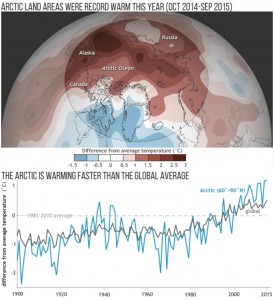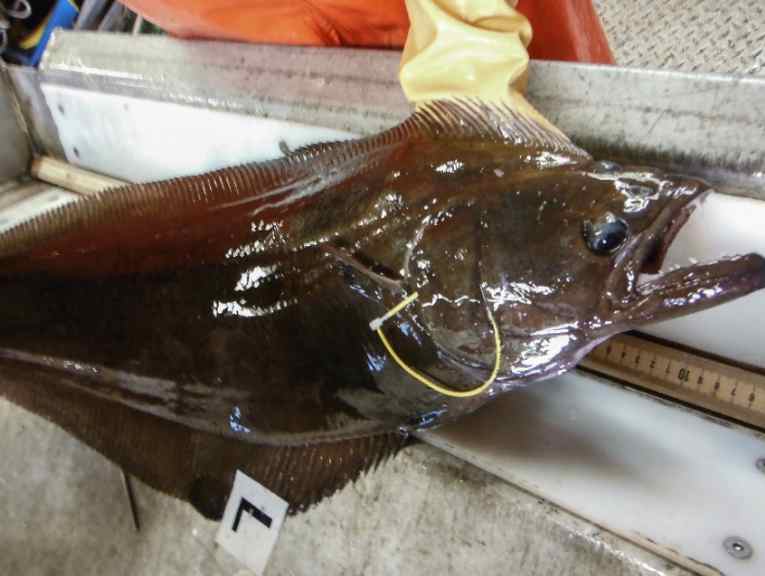
A new NOAA-sponsored report shows that air temperature in 2015 across the Arctic was well above average with temperature anomalies over land more than 2 degrees Fahrenheit above average, the highest since records began in 1900. Increasing air and sea surface temperatures, decreasing sea ice extent and Greenland ice sheet mass, and changing behavior of fish and walrus are among key observations released today in the Arctic Report Card 2015.
“Now in its 10th year, the Arctic Report Card is a key tool to understanding changes in the Arctic and how those changes may affect communities, businesses, and people around the world,” said NOAA Chief Scientist Dr. Rick Spinrad, during a press conference today at the annual American Geophysical Union Fall Meeting in San Francisco. “The Arctic is warming twice as fast as other parts of the planet, which has ramifications for global security, climate, commerce, and trade. This year’s report shows the importance of international collaboration on sustained, long-term observing programs that provide insights to inform decisions by citizens, policymakers, and industry.”
Some 70 authors from 11 countries, including U.S. federal agencies and academics, contributed to this annual peer-reviewed report, guided by an editorial team from the Office of Naval Research, the US Army Corps of Engineers’ Cold Regions Research and Engineering Laboratory, and NOAA. This year’s report features updates on key indicators, as well as new reports on the status of walrus, the northward movement of fishes, increasing river discharge into the Arctic Ocean, and the importance of community-based monitoring. Major findings of this year’s report include:[xyz-ihs snippet=”adsense-body-ad”]
- Air temperature: The average annual air temperature over land areas between October 2014 and September 2015 was 2.3 degrees Fahrenheit (1.3 degrees Celsius) above average, the highest in the observational record which began in 1900, and is a 5.4 degrees Fahrenheit (3 degrees Celsius) increase since the beginning of the 20th Century.
- Sea ice: Maximum Arctic Ocean sea ice extent, which occurred February 25, 2015, 15 days earlier than average, was the lowest extent recorded since records began in 1979. Minimum sea ice extent measured on September 11, 2015, was the fourth lowest in the satellite record since 1979. Arctic minimum sea ice extent has been declining at a rate of 13.4 percent per decade (relative to the 1981-2010 average). First year ice now dominates the winter ice cover, comprising about 70 percent of the March 2015 ice pack, compared to about half that in the 1980s when older, thicker ice was more prevalent. The thinner, younger ice is more vulnerable to melting in the summer.
- Snow cover: While Arctic-wide terrestrial snow cover extent in April was above average, June snow cover in both the North American and Eurasian parts of the Arctic was the second lowest in the satellite record that began in 1967. Arctic-wide June snow extent has declined 18 percent per decade since 1979. Snow cover variability in April through June is important as the Arctic’s transition from winter to summer affects climate and terrestrial ecosystems.
-

Arctic vegetation trends from 2010-2014. (Credit: NOAA Climate.gov image) Greenland ice sheet: For the first time since the exceptional melt of 2012, significant melting (more than 50 percent of the area) occurred on the surface of the Greenland ice sheet in 2015. Melt season was 30 to 40 days longer than average in western, northwestern and northeastern Greenland, but was close to or below average elsewhere on the ice sheet. Between the end of the 2014 and 2015 melt seasons, 22 of 45 of the widest and fastest flowing glaciers terminating in the ocean had retreated, but the advance of 9 relatively wide glaciers resulted in a low annual net loss of 6.4 square miles (16.5 square kilometers).
- Arctic Ocean temperature: As sea ice retreats in summer, sea surface temperature (SST) in all the seas of the Arctic Ocean is increasing. Mean sea surface temperatures in ice-free regions in August 2015 ranged from 32 degrees Fahrenheit (0 degrees Celsius) to 44 to 46 degrees Fahrenheit (7 to 8 degrees Celsius) in the Chukchi, Barents and Kara seas and eastern Baffin Bay off the west coast of Greenland. The Chukchi Sea northwest of Alaska and eastern Baffin Bay off west Greenland have the largest warming trends: nearly 1 degree Fahrenheit per decade since 1982 (0.5 degrees Celsius).
- Arctic Ocean productivity: Melting and retreat of sea ice during spring is leading to an increase in sunlight reaching the upper layers of the ocean, promoting photosynthesis and stimulating the growth of algae (tiny marine plants which form the base of the food chain). Widespread and exceptional phytoplankton blooms were observed in 2015 in Arctic seas along the edge of the continental shelf, including waters to the southwest and east of Greenland, in the Bering Sea between Alaska and Russia, and in the Barents, Kara and Laptev seas north of Russia.
- Vegetation: Arctic tundra greenness, a measure of live vegetation (grasses, sedges, mosses, lichens, shrubs) productivity and biomass, had been increasing over the past two to three decades, as indicated by the satellite record. However, for reasons that remain to be identified, tundra greenness has been declining, or browning, consistently for the past two to four years.

This year’s report also includes guest essays that provide insight on how fish, walrus, and Arctic rivers are responding to changes in the warmer environment:
- Walrus habitat: The decline in sea ice is dramatically changing the habitat for walruses — large marine mammals that traditionally use sea ice for mating, giving birth to young, finding food and shelter from storms and predators. In recent years, large numbers of walrus have been forced to haul out on land in northwest Alaska. This behavior, documented through aerial surveys, has created problems such as overcrowding which has led to stampedes that have killed calves, and difficulty finding food. Walruses must travel longer distances to the ice edge to find food. While walruses have new stressors, their populations have benefited from reduced hunting as more nations adopt conservation measures.
-

Changes in distribution of warm-water and cold-water fishes in the Barents Sea between 2004 and 2012, based on data from Maria Fossheim. (Credit: NOAA Climate.gov image) Subarctic fish: Scientists from Norway and Russia drew on annual ecosystem surveys from the Barents Sea from 2004 to 2013 to show a northward movement of subarctic fish species such as cod, beaked redfish and long rough dab, into Arctic waters. These predators may pose potential problems for smaller Arctic fish that must now face these new warmer-water predators.
- Freshwater discharge: In 2014, and for the first seven months of 2015, the combined discharge of fresh water from eight Eurasian and North American rivers into the Arctic Ocean was 10 percent greater than the discharge in the decade of 1980-89. Scientists attribute the rise in discharge to increasing precipitation linked to global warming.
In 2006, NOAA’s Climate Program Office introduced the State of the Arctic Report which established a baseline of conditions at the beginning of the 21st century. It is updated annually as the Arctic Report Card to document the often-quickly changing conditions in the Arctic. To view this year’s report, visithttps://www.arctic.noaa.gov/reportcard/.
NOAA’s mission is to understand and predict changes in the Earth’s environment, from the depths of the ocean to the surface of the sun, and to conserve and manage our coastal and marine resources. Join us on Facebook, Twitter, Instagram and our other social media channels.
Source: NOAA [xyz-ihs snippet=”Adversal-468×60″]



